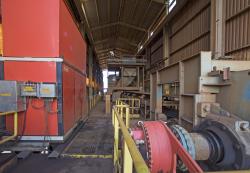

Conveyors are critical to mine production, and certainly to a mine that refines around 350 million metric tons of ore and pellets per year.
One such mine was the first in Brazil to equip a belt conveyor with a Hägglunds hydraulic direct drive system – a milestone in Brazil with significance for the rest of Latin America.
The Hägglunds system replaced an electromechanical drive with independent electric motors, each run at a constant speed and coupled with a speed reducer.
With its infinitely variable speed and resistance to shock loads, the hydraulic direct drive system offered clear production advantages.
But for the mining company, the strongest argument was safety.
The company had carried out a feasibility study, which highlighted potential improvements in safety and beyond.
With a hydraulic direct drive on the conveyor, all rotating parts would be enclosed rather than exposed.
There would be no sensitive couplings, and the motors themselves would have their own internal relief system. In total, this would mean a safer conveyor with greater reliability.
For all of these reasons, a hydraulic direct drive was installed at the mine.
Comprising two hydraulic Hägglunds CB400-320 motors, as well as a hydraulic pump unit and a Rexroth control system, it was installed in only three days.
“The motors were a good choice for the torque demand,” says Sales Engineer, Roberto Akira Koga at Bosch Rexroth, “and the tight integration between our teams helped us get the solution in place quickly.
Since installing the new drive solution, safety has indeed improved. Moreover, the reliability of the belt conveyor is far greater.
According to the mining company’s records, eliminating the low-speed coupling between the transmission and conveyor drive drum has done away with a good deal of maintenance.
“Maintenance is definitely lower with the direct drive solution, and the smoother, softer belt starts reduce wear and tear,” says Mr Akira. “The system now also absorbs any torque peaks, and it can be operated at a wide range of speeds to meet different process requirements.”
In fact, the hydraulic direct drive still has more to offer. Measurements show that the conveyor now carries around 2700 tons per hour, and that its capacity is slightly more than it was with the original drive system.
But thanks to the flow rate and power of the newly installed drive, it is possible to substantially increase the speed or torque without affecting the service life of the drive.
“The diagnostic tests that have been carried out show that the drive system is in excellent condition, and that the mining company can increase its production volume significantly if the needed,” says Kjell Byström, Engineer at Bosch Rexroth. “The company is very satisfied, which has been our experience virtually every time a hydraulic direct drive has been installed on a conveyor. It’s a pleasure to see.”

 Industry News
Industry News
